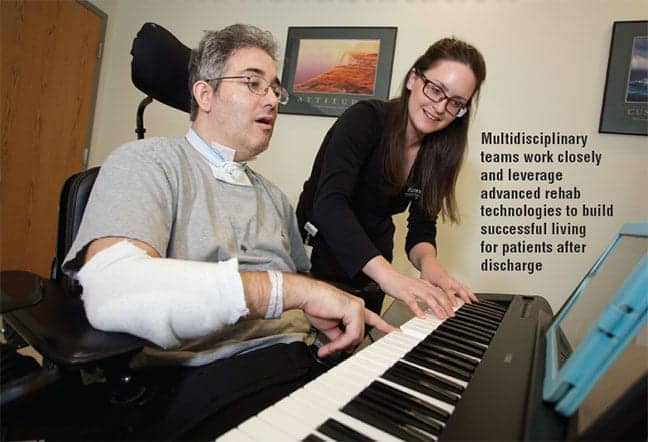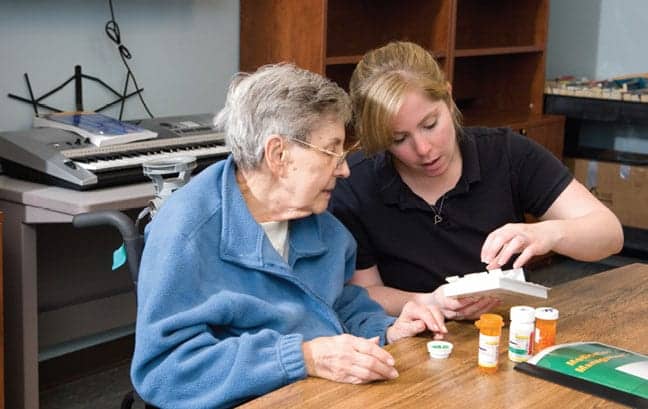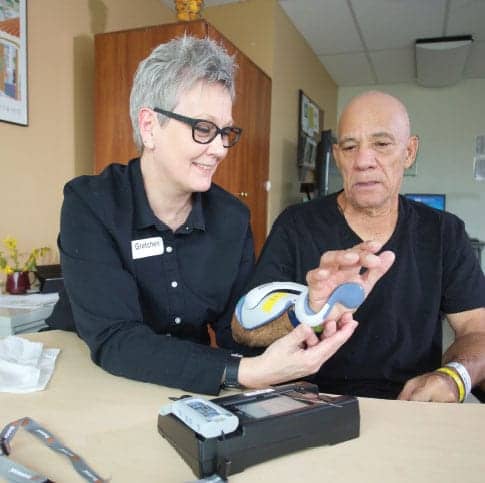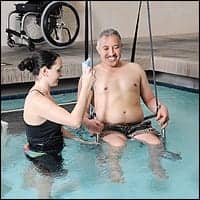
In addition to traditional therapies, Kessler Institute for Rehabilitation patients participate in a variety of specialized programs. Music therapy, for example, can provide meaningful physical and emotional recovery after stroke.
Stroke impacts the lives of more than 795,000 individuals and their families each year. At Kessler Institute for Rehabilitation, a multidisciplinary team of stroke specialists provides the integrated care and treatment to help each patient regain the strength, skills, and strategies to resume life to its fullest. Led by a physiatrist, a board-certified physician specializing in physical medicine and rehabilitation, the Kessler stroke team includes rehabilitation nurses; physical, occupational, speech, and recreation therapists; psychologists and neuropsychologists; and case managers, as well as dieticians, pharmacists, and other clinical and support staff. Together, they tailor treatment to the individual needs and goals of each patient. The hallmark of this program is the level of teamwork that, when combined with evidence-based treatment and leading-edge technologies, supports stronger patient outcomes.
Getting Started
The facility’s interdisciplinary stroke team works closely throughout the continuum of care to deliver a seamless rehabilitation program. This process begins with the initial assessment during which clinical staff evaluate the patient’s medical, physical, and cognitive levels as well as their personal goals and expectations. Because stroke survivors and their families often initially have many questions, concerns, and fears, it is the responsibility of the team members to address those considerations with the aim of minimizing any fears. This is done by providing knowledge and understanding to the patient and the patient’s stakeholders. Team members associated with the patient’s case share information provided by the patient and family to form a more complete and accurate picture of the individual and any family circumstances that might impact recovery. This helps to ensure that what clinical staff learns from the patient and that person’s family is complete and consistent. Based on this profile, the teams works with the patient to establish realistic goals and collaborate on establishing the most appropriate treatment plan.
The stroke team at each of Kessler’s three hospital campuses also works together to orient patients and their families to the rehabilitation setting. This includes everything from discussing how to use the calls, bells, and televisions to understanding their daily schedules to being made aware of various hospital policies and services.
Like many rehabilitation hospitals, the approach at Kessler is to begin preparing for a patient’s discharge upon admission. The goal is to enable every patient to return home, or in some cases, to best prepare him or her for the next appropriate level of care. With this in mind, the team communicates daily and holds weekly team conferences to monitor the patient’s progress, identify any barriers to discharge, and brainstorm ideas and options to promote a safe discharge to home.

Medication management is an important marker for independence at home. Like many rehabilitation hospitals, the approach at Kessler Institute for Rehabilitation is to begin preparing for a patient’s discharge upon admission. The goal is to enable every patient to return home, or in some cases, to best prepare that person for the next appropriate level of care.
Care Matters
Compassion, collaboration, and communication also drive the delivery of patient-centered care. Physicians, nurses, therapists, and other team members of this facility work closely to ensure that hands-on care and advanced technologies balance to meet the needs—and the changing needs—of each patient to help optimize recovery.
In addition to traditional therapies, Kessler patients participate in a variety of specialized programs that foster greater independence, such as medication management, meal management, and community life skills, all of which offer opportunities to develop skills with others experiencing the same or similar challenges. Another unique program is Canine Companions for Independence, through which individuals work with one of the facility’s specially trained dogs to perform various therapeutic tasks. Patients often demonstrate improved participation in therapy sessions when working with their therapist and the facility dog.
Constraint Induced Movement Therapy (CIMT) is an excellent example of evidence-based practice at work. Stroke survivors often express frustration that they are unable to move an arm or leg, and give up. Using CIMT, the therapist “forces” the patient to use the affected limb by restricting use of the unaffected arm or leg. When even the slightest trace movement is recognized, the patient is encouraged and, in fact, the impact on an individual’s attitude can be extraordinary. While high numbers of repetitions in the context of an actual task is needed, patients are also required to practice movement patterns outside of therapy sessions to maintain motivation and gain greater self-sufficiency.
The Tools of Technology
The scope of high-tech devices and equipment available for stroke rehab provides therapists with important options in how they approach the varied rehabilitation needs of stroke survivors. What these technologies have in common, however, is that they are effective in promoting recovery and improving a patient’s strength, skills, and independence.
Kessler embraces a “high-touch, high-tech” approach to treatment, which calls for the use of a wide range of leading-edge technologies to complement traditional therapies. The therapy staff receives comprehensive education and training about the use of this advanced equipment to ensure it is being employed correctly and safely with appropriate patients. Examples of these technological tools includes the following:
- Robotics—One stroke rehab technology the facility uses is a robotic device that works in three dimensions to help patients with absent-to-emerging upper-extremity movement. Training may be entirely passive, or may require the patient to initiate the movement pattern with robotic assist, and may progress to having the patient complete the movement without robotic assistance.
- Exoskeletons—For upper-extremity needs, the facility uses an exoskeleton with integrated springs that embraces the arm from the shoulder to the hand, and counterbalances the weight to enhance function and neuromuscular control. What patients report they enjoy most about this technology is that it is an interactive system that uses a gaming-type format for directing movement and providing feedback. Similarly, for lower-extremity needs, patients may be introduced to other exoskeletal devices to help improve mobility and gait.
- Electrical Stimulation—Clinicians may choose to use an upper-extremity orthosis or lower-extremity orthosis built to provide functional electrical stimulation (FES). Both devices use a wireless form of neuromuscular electrical stimulation to activate weak muscles and facilitate movement, and may improve foot drop. Electrical stimulation technology is also used to treat swallowing disorders common among stroke survivors.
- Virtual Reality—Through the use of a popular consumer-level gaming platform and other computer-based technologies, therapists are able to target a range of motor, visual, perceptual, and cognitive issues, and can even incorporate balance training.
- Body Weight Supported Training—BWST allows safe gait training to be initiated early in the rehabilitation stay while the patient’s body weight is supported through a harness system. Units can be used over a treadmill or over ground, depending on the individual’s needs and progress. Specially trained physical therapists facilitate weight shift and limb advancement for optimal gait mechanics.
- Electronic Aids to Daily Living—In addition to devices that assist with daily activities, there are an increasing number of apps that monitor health, provide reminders such as when to take medications or schedule follow-up appointments, and in general help to make life ahead easier.
Although walking is a primary goal for most stroke survivors, some will require a wheelchair. Kessler’s wheelchair and seating specialists, who are ATP/SMS certified, provide comprehensive assessments to determine the most appropriate options based on the individual’s physical impairments and lifestyle needs. Both basic and high-tech models are available to maximize comfort, postural alignments, and pressure redistribution to prevent skin breakdown.
Bringing Research to Life
The stroke teams at Kessler Institute’s three campuses have a unique opportunity to work directly with the research scientists at Kessler Foundation, a collaboration that facilitates learning across both organizations. At weekly neuro rounds, for example, a case study is presented to offer insight into how research is being translated into clinical practice.
Most recently, for example, a Neglect Assessment Protocol and a Prism Adaptation Protocol for the treatment of spatial neglect in stroke patients were adopted. It is reported that up to one-third of all stroke patients experience some form of neglect, but often that neglect is neither recognized nor reported. Working with Kessler Foundation, the stroke team has been educated and trained on the Kessler Foundation Neglect Assessment Protocol (KF-NAP), which is now a required screening tool for all stroke patients at Kessler Institute. It is used to help identify patients with visual special neglect in three areas: personal, peri-personal, and extra-personal space. Because patients with neglect may require additional time to recover their skills, the KF-NAP has helped the team to better plan for discharge. Similarly, prism awareness training has proven effective in treating some types of neglect and in helping patients achieve better outcomes.

Gretchen March, OTR, uses an upper-extremity orthosis to provide functional electrical stimulation. The device is an advanced rehab technology often used among stroke patients to activate weak muscles and facilitate movement.
Planning for the Future
Extensive education and training is provided by facility staff to patients and their families as a way to prepare them all for the rehabilitation experience and their lives moving forward. This is a collaborative effort that begins prior to admission when Kessler’s hospital liaisons first meet with the individual, and continues long after discharge with support groups and follow-up care, including outpatient services. Throughout the stay, patients also learn to how to best manage their condition, deal with any emotional challenges, and adapt to any changes that they face. The “Steps for Wellness” program, for example, emphasizes the lifestyle changes that can help to minimize the risk for recurrent stroke. Also, family members are provided with the information and training they need to support and care for the survivor, as well as guidance about any home modifications or equipment that may help in the transition to home.
Upon discharge, most stroke survivors will continue their rehabilitation to build on the gains they have made. Individuals can benefit from an array of outpatient services, including Kessler’s cognitive rehabilitation, driver rehabilitation, and step-down programs. The effectiveness of these programs that has been observed is due in part to the continuity of care, communication, and collaboration between Kessler’s inpatient and outpatient stroke specialists.
Also important is feedback from patients and their families. Input gathered from family meetings, focus groups, satisfaction surveys, and other channels enables the team to continually identify opportunities for quality improvement and ways to further enhance the rehabilitation experience at Kessler Institute.
New Normal
The stroke team at Kessler Institute for Rehabilitation guides stroke survivors and their families through the often complex challenges they face, with the aim of helping them understand their condition, manage goals and expectations, and prepare for what is typically described as a “new normal.” Through specialized treatment, advanced technologies, technology, education, training, and support, patients are able to optimize functional outcomes and reclaim their independence. RM
Gretchen March, OTR, is an Advanced Clinical Specialist with an expertise in neurological rehabilitation. She has developed and implemented CIMT protocols for Kessler Institute for more than 30 years bringing evidence based practice into the clinical setting. March is involved in using technology as an adjunct to traditional therapies for upper extremity motor control with excellent outcomes.
Lorraine Fuentes, PT, graduated with a BS in physical therapy from The University of New England and currently works as an advanced clinical specialist at Kessler Institute for Rehabilitation in Saddle Brook, NJ, on the stroke unit.
Danielle Weiser, PT, DPT, NCS, earned a Doctorate in Physical Therapy from Thomas Jefferson University. She practices at Kessler Institute for Rehabilitation in Saddle Brook, NJ, as a clinical specialist treating patients with neurologic conditions in the inpatient setting. She holds an American Board of Physical Therapy Specialties certification in Neurologic Physical Therapy and is a member of the APTA, NJ chapter.
Eileen Yorke, OT, ATP, SMS, is an occupational therapist who has been practicing for more than 20 years in various settings, including acute rehab and early intervention. She specializes in the area of wheelchair seating and positioning, and has earned her ATP and SMS certifications. For more information, contact [email protected].



